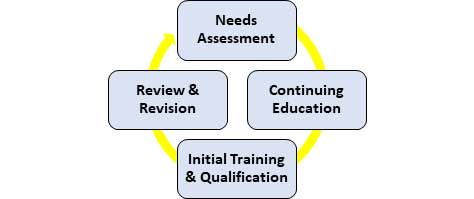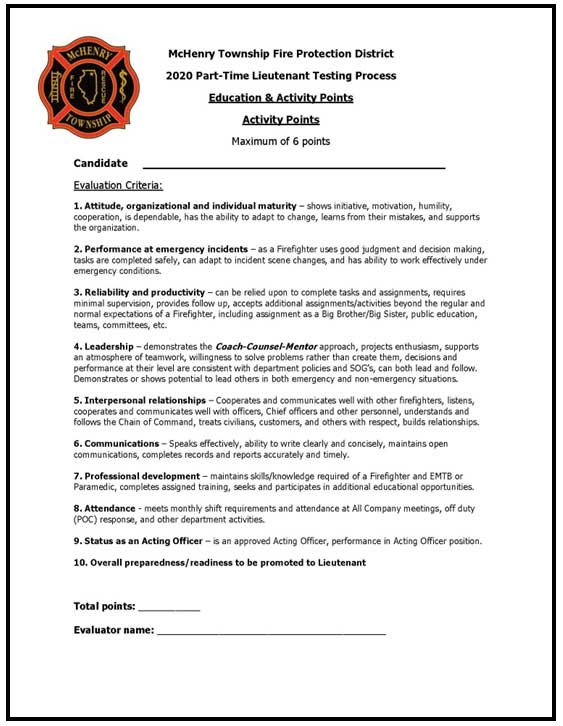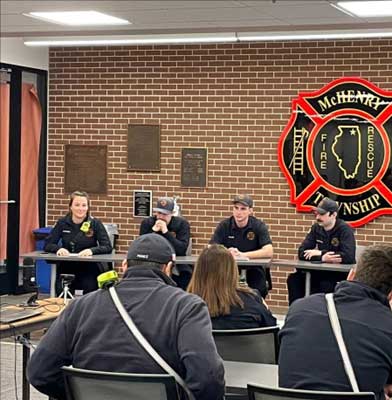By Rudy Horist
All images by author
In many fire departments, one of the most common “we need to do more” areas is officer development. Although it’s common to invest significant time and funding for initial firefighter training, when it comes to initial and ongoing officer training, other than with the possible exception of state-level certification courses, that is where it frequently drops off. With the nationwide ongoing loss of experienced officers in both volunteer and career departments due to retirements and other factors, the need has never been greater for quality, comprehensive, and ongoing training for fire officers.
- Officer Development Program: Where to Start and Lessons Learned
- What Is an Expectation? A Company Officer’s Guide
- Climbing the Ladder of Success in the Volunteer Fire Service
- Bridging the Firefighter-to-Officer Gap: The Acting Company Officer Program
In recent years that situation has begun to change as more fire departments have recognized this need. Some agencies have developed excellent and comprehensive officer development programs. The amount of resources available for program development has also significantly increased with much more being available in a variety of formats. But even with these resources and other examples to draw on, many training officers and chief officers are still left trying to figure out where to begin.
The answer lies in having a step-by-step method or template for developing an officer development program that meets the needs of your particular fire department. Just because something works for one department doesn’t mean it will work the same way or produce the same results as it does for another department.

This series of articles will focus on a four-step approach for developing a program that meets the needs of your department. Starting first with needs assessment and prioritizing your needs, it will then move through continuing or ongoing education, initial officer training, and review and revision. Along the way we will also cover a variety of resources that are available.
Whether you have an existing program or are starting from square one, an important but sometimes missed first step is to conduct a needs assessment. Sometimes as training officers or chiefs we “think” we know what the problem is and the needs are, and sometimes we are right, but other times we might be wrong. Taking the time to do a needs assessment will help to make sure that we reach our target. Taking this step in the process also provides an opportunity to assess other department needs and possible areas for improvement.
Doing a needs assessment is not a one-person job and its recommended to assemble a team or committee to work on the process. This can be your officer group or better yet maybe a committee that represents a cross section of the department, including full-time and part-time members, officers, firefighters, management, and your union local, if you have one. In my organization, we did our first needs assessment a few years ago with primarily our officers and more recently a professional development committee was established to accomplish the task.
There are many different ways to conduct a needs assessment for officer development, some simple and others more complex. Whichever method you choose, some important considerations include:
- What are the expectations of an officer?
- What is your officer selection or promotion process?
- What are the needs of the fire department?
- What are the needs of your current and future officers?
- What national, state, and local standards apply?
Expectations of an Officer
How have the expectations of a fire officer changed since you were first promoted, or first joined the fire service? I’m willing to bet they have increased, become broader, and expanded into areas that originally were “not part of the job.” What will they become in the next five, 10, or 20 years?
When considering this question, look at it from the perspective of the department. While that is certainly important and will aid in developing your list of topics and needs, this is also an opportunity to take a deeper dive into what the many of your other “audiences” expect from an officer. This includes the community, our firefighters and their families, and the fire service as a whole. Finally, what do the officers expect from themselves? Examining each of these can lead to both discussion and introspection.
The Officer Selection or Promotion Process?
The requirements and process that your department uses for selecting fire officers is another important part of the needs assessment process. The methods encompass a range of possibilities: some very structed and formal, some election or appointment-based processes, some in which whoever gets into the right front seat is expected to carry out certain functions. Taking the time to evaluate this not only helps to identify the knowledge, skills, and abilities (KSAs) that someone may possess when getting promoted, it also can help identify areas for change or improvement. If you also using acting officers, how does that approach fit into the process?
An example of this is the process my organization went through in preparation for our last part-time lieutenant’s promotion process. We had a formal process in place for many years, but after trying some different things, we realized the need to step back and evaluate what was really important, to determine what we really wanted to assess and measure.
- Succession Planning: Identifying, Developing, and Retaining Quality Chief Fire Officers
- The Job of a Fire Officer: What the Books Don’t Teach About Managing and Leading
- The New Officer: Your Leadership Journey Begins
- The Prime Directive
We started by asking our current officers a simple question: “What knowledge, skills, and abilities should a firefighter have before being promoted?”We received back over 100 responses and while many were the ones that we expected and wanted to see—size up, building construction, fire behavior, establishing command, etc.—the vast majority included a lot of topics unrelated to the fireground, those things sometimes referred to as “soft skills.” Examples included:
- Being adaptable
- Being motivated
- Having pride in the job
- Being able to make good decisions
- Being organized
- Being a coach, counsel, or mentor
- Leading by example
- Having strong interpersonal skills
- Being a problem solver
We then took that list and looked at the different parts of the promotional testing process to see where we could plug those items in. Where could we assess and evaluate these topics? Some were incorporated into the written exam, others the assessment center, and some the oral interview. It also formed the basis for the department evaluation or department point’s part of the process and even the list of expectations that are communicated to new officers. An additional benefit to doing this is we could say to the organization that the process included and reflected the input of our current officer corps. This also then provided a list for identified topics and needs for our officer development program.


Needs of the Fire Department
How have the needs of the department changed, and what will they be in the next five or 10 years? This includes types of responses, changes in the community, retirements and turnover in the officer ranks, new personnel, and future challenges. Is the department experiencing budget decreases or a changing pool of potential officer candidates? Is there a decrease in the number of personnel responding to incidents that will dictate operational changes?

Needs of Current and Future Officers
As we develop our program, we want it to meet not just the needs of our current officers but also those to come. What will that look like in the next five or 10 years? There are many ways to assess this, from formal surveys and strengths, weaknesses, opportunities, and threats (SWOT) analysis, to observation at training and incidents, to simply asking them what they believe the needs are.
Along with conducting a SWOT analysis, a unique approach that our professional development committee did was to include input from the firefighters as to what they believe “makes a good boss.” Assembling a group of both full-time and part-time firefighters with varying levels of experience, they held a panel discussion that was attended by firefighters, company officers and all of our chief officers. This interesting approach provided additional information as to the training and education needs of not only our current officers but those who will become officers in the future.
Job Descriptions
Are your job descriptions up to date, accurate, and reflect what the job is versus what it might have been several years ago? Does it meet any legal requirements? An excellent reference for developing or revising your job description for officers is National Fire Protection Association (NFPA) 1021, Standard for Fire Officer Professional Qualifications.
National, State, Local Standards
There are several national standards that provide an excellent reference for this part of the needs assessment process. These include:
- NFPA 1021, Standard for Fire Officer Professional Qualifications
- NFPA 1026, Standard for IMS Professional Qualifications
- NFPA 1500, Standard on Fire Department Occupational Safety, Health and Wellness Program
- NFPA 1521, Standard for Fire Department Safety Officer Professional Qualifications
- NFPA 1561, Standard on Emergency Services Incident Incident Management System and Command Safety
NFPA 1021 in particular is the professional standard that many state certification programs for fire officer are based upon.
Another great reference and excellent program is the Center for Public Safety (CPSE) credentialing program for fire officers. There are currently six different credentials available, from Fire Officer to Chief Fire Officer, and each level identifies requirements and criteria in several different areas, including education, experience, technical competence, community involvement and others.
Within your own state, what are the requirements to become a certified fire officer? Again, these most likely will incorporate NFPA 1021 as a reference. Also remember to include any local or legal requirements from department, municipality, or district.
Putting It All Together
To do the needs assessment in a comprehensive way takes time and again it is not a one-person job. It is also not a “one and done” type of activity, as to keep your program up to date and accurate will require that you revisit at least parts of the process from time to time.
As an example, one of the previous needs assessments from our department identified some of the following items:
- Currently integrating part-time and full-time officers
- 33 part-time officers and six full-time officers
- Average time in rank of seven years
- 15 acting officers and the need to increase that number
- The job description for an officer needed to be updated
- Increasing loss of senior, experienced officers
- Younger officers and acting officers
- Increased expectations
- Changes to the promotion process
Each of those, along with the topics identified through each step of this process, will help ensure that you build a comprehensive list of the subjects and topics needed to meet the needs of your department. The next step will be to being organizing and prioritizing what will be a long list of topics.
In the next article we will discuss prioritizing and determining which topics belong in your initial training, ongoing training or both.
Rudy Horist is chief of the McHenry Township (IL) Fire Protection District with 39 years of service. He has a master’s degree in public safety administration from Lewis University and is a graduate of the Executive Fire Officer Program at the National Fire Academy.

